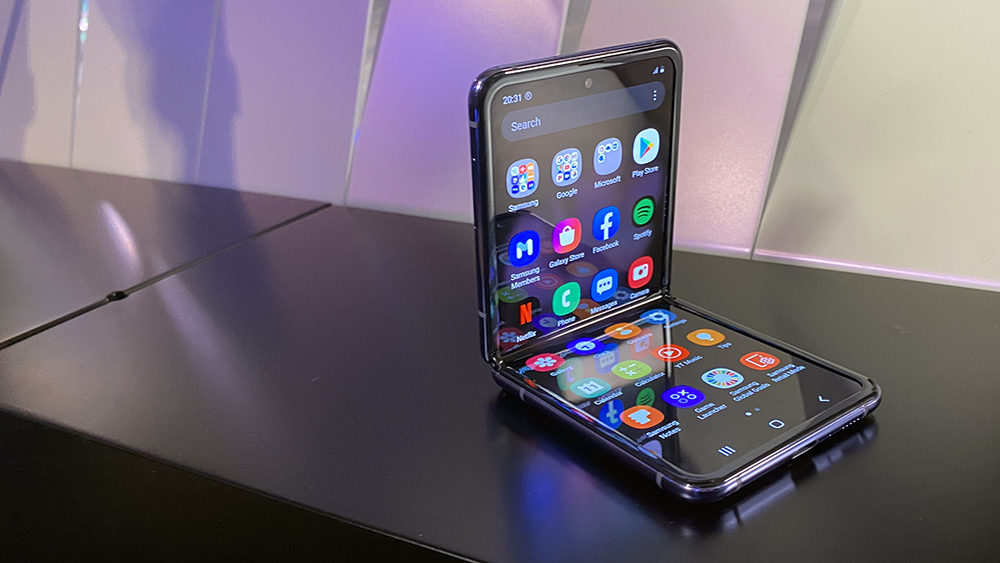Early Verdict
Pros
- +
Stylish and nostalgic design
- +
Two-screen multi-tasking
- +
Cheaper than Galaxy Fold
Cons
- -
Some specs aren't quite flagship
Why you can trust What Hi-Fi?
Samsung will no doubt be hoping the third time’s a charm proverb won't apply to its foldable phone success. Its second-ever attempt is here, it's aiming to steal you away from your boring flat phone, and it reeks of delicious nostalgia.
The Galaxy Z Flip arrives five months after the re-release of the initially toiled Galaxy Fold (Samsung’s first foray into a foldable phone), and it’s a) cheaper, and b) very different in form factor. Will this be the Samsung foldable deserving of fandom? Quite possibly.
We spent some time with the bendy device at Samsung's Galaxy Unpacked UK launch event and here are our first impressions.
Design
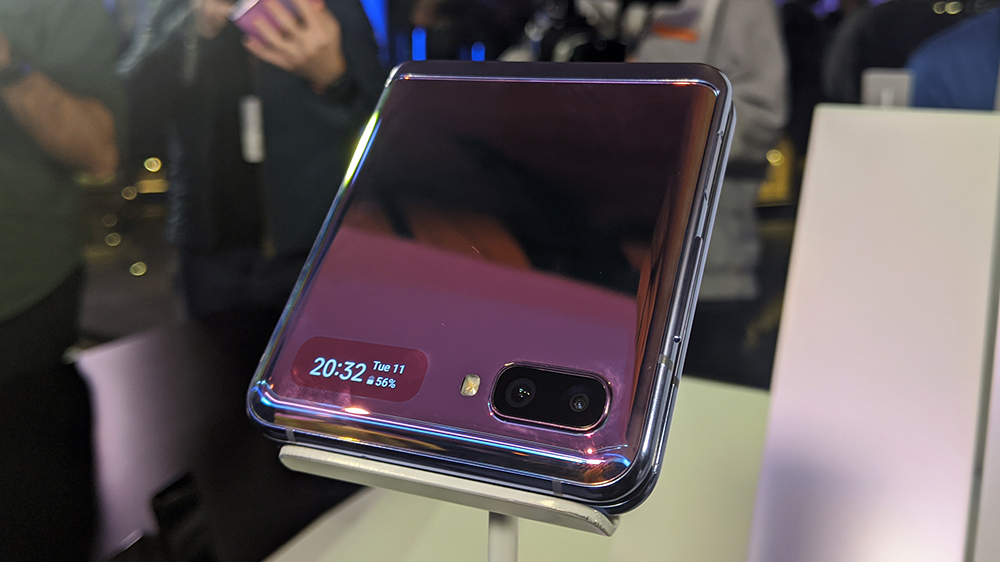
While the Galaxy Fold is a very tall and narrow device when folded and a tablet-like form when unfolded horizontally, the Samsung Galaxy Z Flip looks more akin to a traditional phone. It measures 167 x 74 x 7.2mm when open, with the top half of the screen able to fold (or rather flip) down over the bottom half like a classic clamshell phone to create a compact and thus much more pocketable, square-ish shape (87 x 74 x 17mm) – similar to the Motorola Razr. For that palm-sized, 183g design alone we believe it’ll find much more fanfare.
What plagued the first iteration of the Fold was a lack of unity between the screen and hinge – there were multiple examples of the screen bubbling above the hinge – so naturally Samsung has redesigned the joint for the Z Flip. The ‘freestop’ hinge allows the phone to stay open at almost any angle, similar to a laptop.
Samsung suggests this will come in useful when, for example, you’re propping it up in an ‘L’ shape for Google Duo video calling. We can imagine it being handy for taking photos at certain angles, or the odd time-lapse too.
Its resilience to remain at certain angles means there’s a reassuring stiffness to the hinge design so don’t expect to be able to flip it open with the flick of your wrist or even open it easily with one hand. Samsung claims you can fold and unfold it over 200,000 without issue.
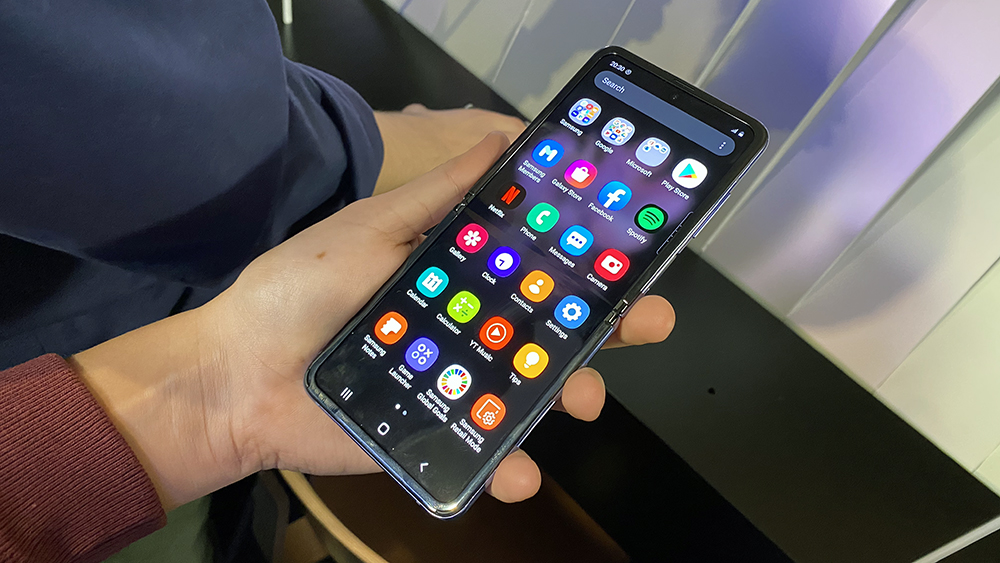
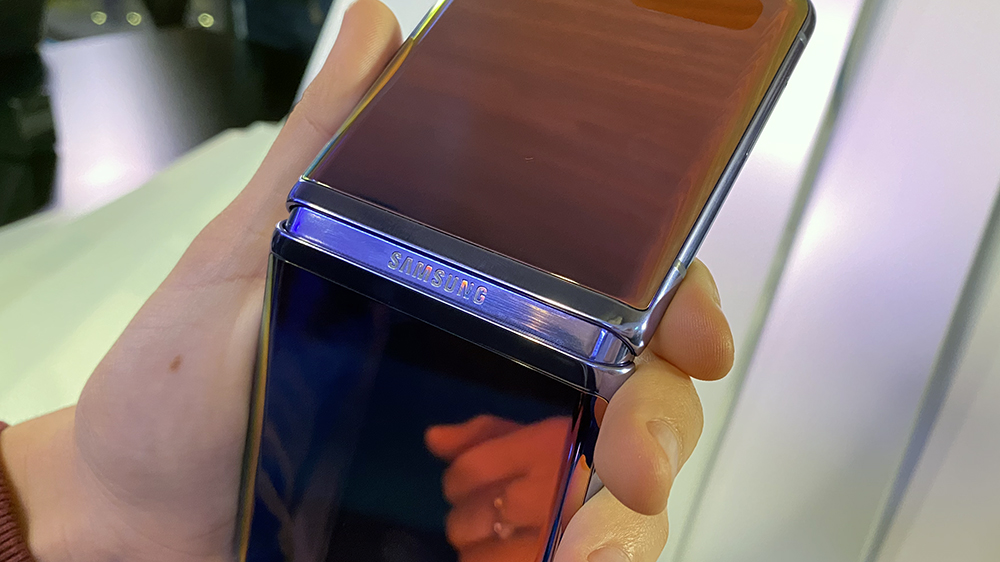
A ‘fibre shield’ promises to keep dust and other pesky particles out of the inherently small gap created when the hinge is open, too, so that nothing makes its way into the handset’s internals.
The hinge is pretty discreet, although not completely invisible, both when the screen is fully open flat and under the crease when it’s clammed up. Fingers crossed they play ball with each other over time.
The power button doubles as a fingerprint scanner for biometric screen unlock (face recognition is also available when unfolded via the front, inside camera). A double press, when closed, fills the 1.1in display in the corner with a camera viewfinder so you can shamefully snap a selfie with just a quick wave at the screen.
Similarly, when you want to snap a photo using the rear camera that same small display window turns into a viewfinder for your subject, so they can check they're happy with their look. Gimmicky? Perhaps, but it could also be super useful. When not in camera mode, the cover display can show information such including message notifications, time, date and battery life.
Screen & specs
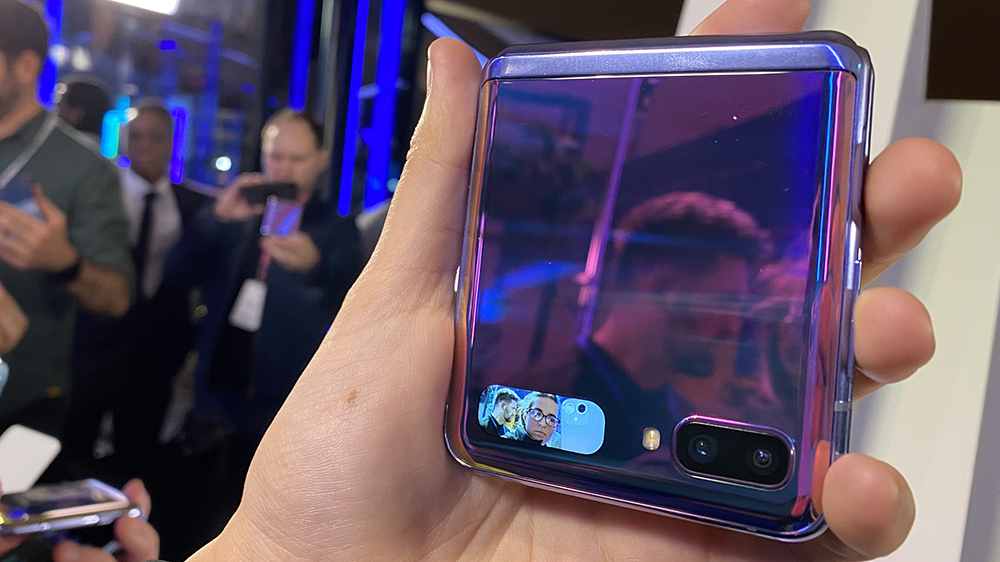
The main screen is a 6.7in AMOLED flexible glass display with a 2636x1080 resolution which, for reference, has a lower ppi (pixels per inch) ratio than the also just announced Samsung Galaxy S20 (425ppi compared to 566ppi). In other words, buying the funky, foldable phone rather than the 'standard' flagship means you get a bigger but lower-resolution screen.
While the Z Flip seemingly (and understandably) doesn’t have the sheer crispness of the new Galaxy flagships’ impressive displays, its screen pops with vibrant colour and should be a good size for watching video on the move thanks to its cinematic 21.9:9 ratio.
Besides working as one big screen, you can actually perform different functions in each half with certain compatible apps. For example, with YouTube you can watch a video in the top half and comment on what you're watching in the bottom section.
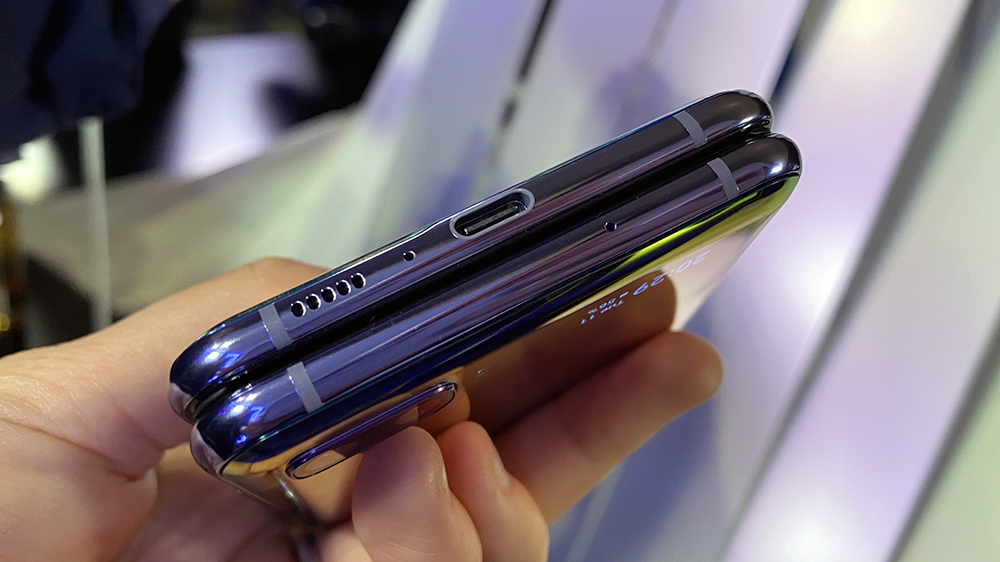
Under the skin is a Snapdragon 855+processor that's backed up with a respectable 8GB of RAM and 256GB of built-in storage. Interestingly, while the Z Flip's processor is perhaps a touch more powerful than that of its S20 siblings (at least at maximum output), the latter is available with more RAM so will likely run faster.
The S20 line-up has also been blessed with bigger batteries too – between 4000mAh and 5000mAh, compared to the Z Flip’s 3300mAh pack – and you get more storage options (up to 512GB), too. The Z Flip is compatible with wireless charging.
Camera
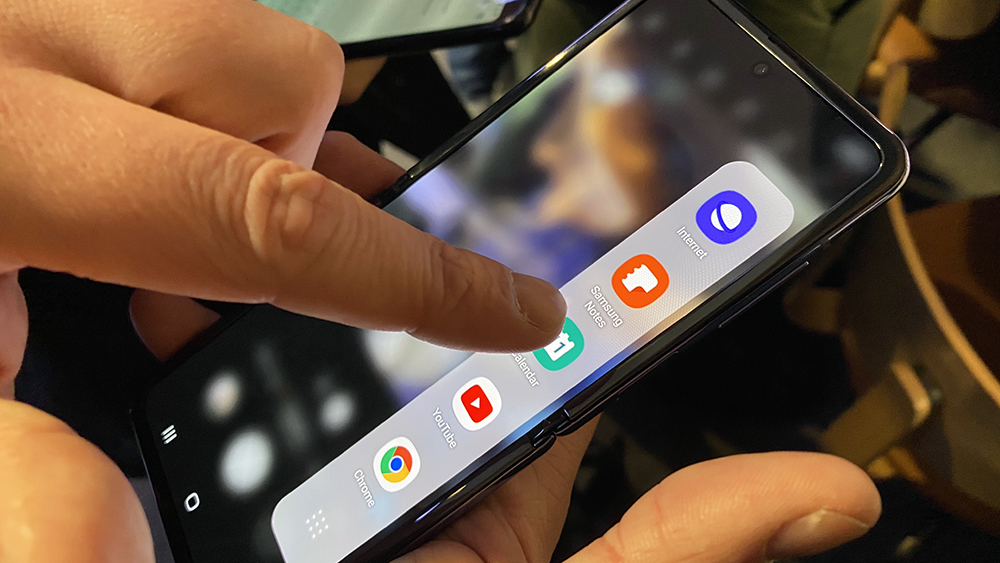
The Z Flip’s camera is somewhat overshadowed by the impressive photographic hardware in the S20 series too with its by comparatively modest dual lens (12MP ultra-wide and 12MP wide-angle) arrangement, complemented by a 10MP selfie camera on the inside.
But the Z Flip is still capable of HDR10+ recording, and benefits from Samsung’s new (and household) AI software modes – our favourite of which is Single Take. Take a short video and in Single Take mode the phone will automatically create a small collection of the best photo and video clip moments captured within it.
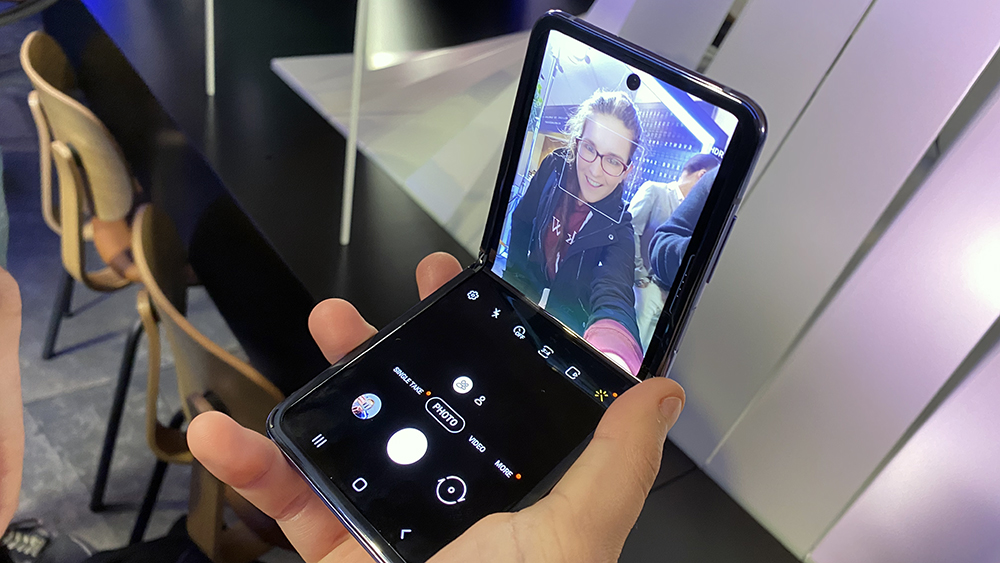
Initial verdict
Indeed, while the new S20s pip the Z Flip in many aspects (display resolution, camera hardware and battery size) and leaves the bendy blower with what could be considered 2019-like specs, what sells the foldable is of course its unique form and cinematic display. And for many that’ll no doubt be a big sell worth the £1300 / $1380 asking price.
At first glance, the Z Flip seems a solid entrant into the market, and we pray it lives an untroubled existence and stands as a good advert for foldable phone success. For now we’ll prepare to hold our breaths when it’s released on February 14th...
MORE:
Hands on: Samsung Galaxy S20 Ultra review
Samsung officially unveils Galaxy S20, S20+ and S20 Ultra
New Samsung Galaxy Buds+ boast excellent earbud battery life
What Hi-Fi?, founded in 1976, is the world's leading independent guide to buying and owning hi-fi and home entertainment products. Our comprehensive tests help you buy the very best for your money, with our advice sections giving you step-by-step information on how to get even more from your music and movies. Everything is tested by our dedicated team of in-house reviewers in our custom-built test rooms in London, Reading and Bath. Our coveted five-star rating and Awards are recognised all over the world as the ultimate seal of approval, so you can buy with absolute confidence.
What is a hands on review?
'Hands on reviews' are a journalist's first impressions of a piece of kit based on spending some time with it. It may be just a few moments, or a few hours. The important thing is we have been able to play with it ourselves and can give you some sense of what it's like to use, even if it's only an embryonic view.
